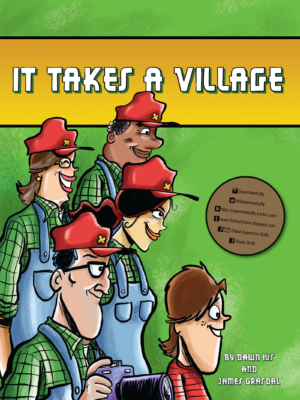
Kindergarten Learning Objectives for “It Takes a Village”
Jump to Subject

English Language Arts
General Learning Objective
1. Students will listen, speak, read, write, view and represent to explore thoughts, ideas, feelings and experiences.
Specific Learning Objectives
1.1 Discover and explore
Express ideas and develop understanding
- Share personal experiences prompted by oral, print and other media texts
- Talk about ideas, experiences and familiar events
Experiment with language and forms
- Talk and represent to explore, express and share stories, ideas and experiences
1.2 Clarify and Extend
Consider the ideas of others
- Listen to experiences and feelings shared by others
Combine Ideas
- Connect related ideas and information
Extent Understanding
- Express interest in new ideas and experiences
General Learning Objective
2. Students will listen, speak, read, write, view and represent to comprehend and respond personally and critically to oral, print and other media texts.
Specific Learning Objectives
2.1 Use Strategies and Cues
Use prior knowledge
- Connect oral language with print and pictures
- Understand that stories, information and personal experiences can be recorded in pictures and print and can be listened to, read or viewed
- Expect print and pictures to have meaning and to be related to each other in print and other media texts
Use comprehension strategies
- Ask questions and make comments during listening and reading activities
- Recall events and characters in familiar stories read aloud by others
2.2 Respond to Text
Experience various texts
- Participate in shared listening, reading and viewing experiences, using oral, print and other media texts from a variety of cultural traditions and genres, such as picture books, fairy tales, rhymes, stories, photographs, illustrations and video programs
- Listen and view attentively
Construct meaning from texts
- Relate aspects of oral, print and other media texts to personal feelings and experiences
- Talk about and represent the actions of characters portrayed in oral, print and other media texts
- Talk about experiences similar or related to those in oral, print and other media texts
2.3 Understand Forms, Elements and Techniques
Understand forms and genres
- Experience a variety of oral, print and other media texts
Understand techniques and elements
- Develop a sense of story through reading, listening and viewing experiences
- Identify the main characters in a variety of oral, print and other media texts
General Learning Objective
3. Students will listen, speak, read, write, view and represent to manage ideas and information.
Specific Learning Objectives
3.1 Plan and Focus
Focus Attention
- Attend to oral, print and other media texts on topics of interest
- Make statements about topics under discussion
3.3 Organize, Record and Evaluate
Evaluate information
- Share new learnings with others
3.4 Share and Review
Share ideas and information
- Share ideas and information about topics of interest
Review research process
- Share information-gathering experiences
General Learning Objective
4. Students will listen, speak, read, write, view and represent to enhance the clarity and artistry of communication.
Specific Learning Objectives
4.3 Present and Share
Demonstrate attentive listening and viewing
- Make comments that relate to the topic being discussed
General Learning Objective
5. Students will listen, speak, read, write, view and represent to respect, support and collaborate with others.
Specific Learning Objectives
5.1 Respect Others and Strengthen Community
Relate texts to culture
- Explore oral, print and other media texts from various communities

Health
Topic: Life Roles and Career Development
General Learning Objective
Life Learning Choices
Students will use resources effectively to manage and explore life roles and career opportunities and challenges.
Specific Learning Objectives
L–K.6
- Demonstrate awareness of the ways in which people take care of responsibilities in the home and school
Topic: Volunteerism
General Learning Objective
Life Learning Choices
Students will use resources effectively to manage and explore life roles and career opportunities and challenges.
Specific Learning Objectives
L–K.7
- Identify ways to help

Science
Topic: Environment an Community Awareness
General Learning Objective
The child demonstrates curiosity, interest and a willingness to learn about the environment and community.
Specific Learning Objectives
- Becomes aware of the five senses and how they are used to explore, investigate and describe the world
- Explores and investigates objects and events in the environment
- Demonstrates awareness of the properties of objects and events in the environment, by:
- Describing some properties
- Sorting objects according to common properties; e.g., colour, size, shape and texture
- Arranging objects or events in logical order
- Matching objects or events as being the same as or going together
- Distinguishing between similar objects, based on one or more characteristics
- Becomes aware of the relationship between cause and effect
- Generates ideas to make personal sense of objects, events and relationships.
Topic: Environment and Community Awareness
General Learning Objective
The child uses materials in the environment and community and becomes aware of how others use materials.
Specific Learning Objectives
- Describes the function of some common objects found in and around the home and the community
Topic: Environment and Community Awareness
General Learning Objective
The child explores familiar places and things in the environment and community.
Specific Learning Objectives
- Recognizes familiar animals and their characteristics and surroundings; e.g., farm and zoo
- Identifies familiar sounds in the environment and community; e.g., school, home, weather, animals and machines.

Social Studies
Topic: K.1 I Am Unique
General Learning Objective
Students will demonstrate an understanding and appreciation of the multiple social, physical, cultural and
linguistic factors that contribute to an individual’s unique identity.
Specific Learning Objectives
K.1.1
K.1.2
Appreciate the unique characteristics, interests, gifts and talents of others:
K.1.3
Examine what makes them unique individuals by exploring and reflecting upon the following questions for inquiry:
Topic: K.2 I Belong
General Learning Objective
Students will demonstrate an understanding and appreciation of the characteristics and interests that unite
members of communities and groups
Specific Learning Objectives
K.2.1
K.2.2
Value and respect significant people in their lives:
K.2.3
Appreciate how their participation in their communities affects their sense of belonging (CC, I)
K.2.4
Examine the characteristics and interests that bring people together in groups by exploring and reflecting upon the following questions for inquiry:
K.2.5
Examine ways in which people create a climate of cooperation by exploring and reflecting upon the following questions for inquiry:
• What are the rules at home, at school and in the community? (PADM)
• Are there similar rules at home, at school and in the community? (PADM)
• What are the benefits of working cooperatively with others? (CC)
• In what ways can people contribute to a group or community? (CC)
• What actions show care and concern for the environment? (C, LPP)